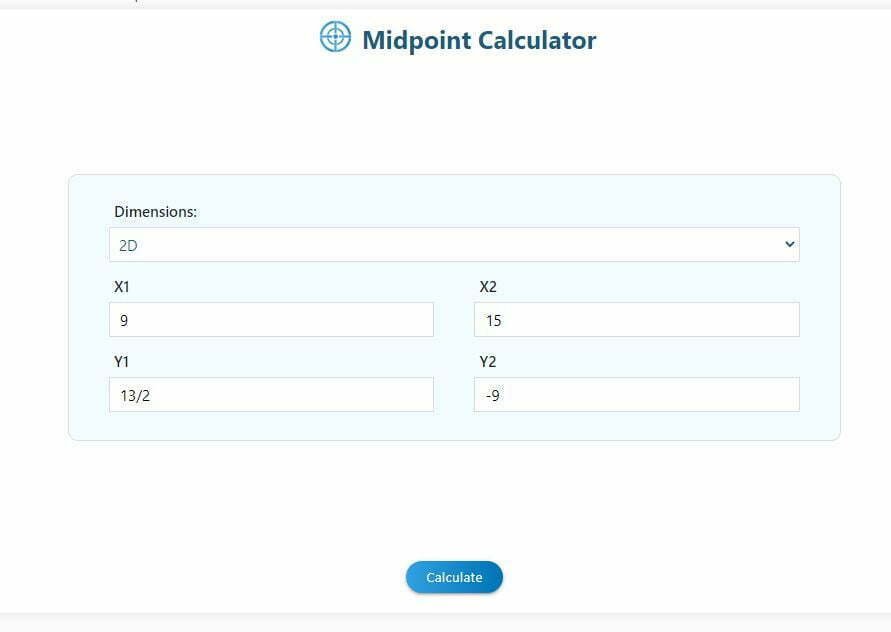Midpoint
In geometry, the midpoint of a segment is the isobarycenter of the two ends of the segment. In the more specific context of Euclidean geometry, it is also the point of this segment located at an equal distance from its ends.
Geometry is quite tough for many of the students. However, it is quite necessary to have clear concepts about the geometrical elements for achieving success. Students should focus keenly on it for excelling in their studies. It is highly essential when you choose engineering as a career. Math students must grab the amazing knowledge about algebra and geometrical concepts. These include mean, median mode, midpoint, slope, theorems, and many others.
No doubt, it is a bit rough subject to comprehend. But, those who develop an interest in it can easily excel from other students. When the basics are strong, then there is no hurdle in passing the exams. Indeed, students with excellent concepts can easily share their ideas with other students for better comprehension.
What is Midpoint?
The line segment is a significant part of geometry, and its middle part is known as the midpoint. When it comes to the calculation of the midpoint, then it must be accurate. Any mistake in calculation can lead to incorrect answers, which can affect the further calculation.
The midpoint calculator is the digital tool available online which intends to calculate the line segment’s midpoint with optimum accuracy. Midpoint is actually the point that is situated exactly at the mid. It means that both endpoints at the line segment are at an equal distance from the midpoint. It would not be wrong to say it as the centroid point. Midpoint is the main point that bisects the whole line segment into two halves. It helps in the determination of the whole length of the line segment.
How to Calculate Midpoint?
Hopefully, the concept about what the midpoint actually is, is clear to the students. Now, moving towards the other critical other, which is about the calculation of midpoint. Midpoint is known to be a great source for measuring the endpoint distance from each other.
The calculation of the midpoint is amazingly simple. If the line segment’s length is known, then divide it by 2, and the resultant value would be the midpoint of that respective line segment. The alternative method is the summation of both x coordinates of each endpoint. These are then subjected for division by 2.
The calculation of midpoint demands both coordinates x and y. For the x coordinate, both values of x1 and x2 should be known. Similarly, for the y coordinate, the values for the y1 and y2 must be known. Midpoint formula calculator intended to access these values for giving the instant outcomes. All of these values are allowed to enter into the formula. When you figure out these values, then ensure to label these as (x1,y1) and (x2,y2) on the line segment. After successful labeling and entering these values, the next step in adding these to the parentheses. Afterward, the midpoint calculation demands the division of output with digit 2. It ensures to divide the line into 2 segments right from the center point. The value obtained is the required resultant.
Fractions (mathematics) | Definition, Explanations, Exercises and Answers
Why is Midpoint Needed?
When cutting the whole segment into two equal parts is the main requirement, then a midpoint is required. We need to analyze the central point in such a scenario. For doing so, one can use a manual calculation or a ruler. The coordinate for both the endpoint sections are involved in it. It helps to develop or create a new coordinate. This coordinate can easily figure out when the values are entered in the midpoint formula. It finds its practical application in architectural work. The unequal distance of the line segment can lead to differences or flaws in construction. The proper distance must be measured properly through the midpoint calculator. It not only helps in finding the midpoint of the horizontal line but also for the vertical line. The difficulty arises when points are unaligned.
Illustration with Example 1:
The most frequent query of how to calculate midpoint must be solved fabulously. Nothing can be more beneficial than the use example. Let us exemplify it properly to grab the whole concept. Suppose we have the range 2-5. The first step is to calculate the class limit for this range. The class limit includes both the upper-class limit and lower class limit. The upper-class limit and lower class limit for this range would be 5 and 2, respectively. Now, you have to sum up the values of these class limits, i.e.,the addition of 2 and 5. The resultant value would be 7. Now, the last step is the calculation for the midpoint, which would be accomplished through the division of this resultant value. Divide 7 by 2, and you will get the value of the midpoint. It would be 3.5 for the range of 2-5.Similarly, you can calculate the midpoint for any predefined range such as 0 to 60, 70 to 90, 5 to 9, or any other.
Illustration with Example 2:
The above-given example was super easy for understanding the calculation of the midpoint. Now, let us consider this example where we have x and y coordinates with their initial and final values. The formula for the midpoint is given as:
Midpoint Formula = x1+x2/2 + y1+y2/2
Here, we have x coordinates’ values to be 5 and 3 while the values for the y coordinates are 1 and 7. Putting these values in the midpoint formula, we get;
Midpoint = (5 + 1 / 2) + (3 + 7 / 2)
Midpoint = (6 / 2) + (10 / 2)
Midpoint = (3) + (5)
Midpoint = 8
One thing about which it is required to be cautious is the values of coordinates. The wrong input would obviously generate the wrong output. So, one must be quite vigilant and careful about the values of both coordinates.
The chances of errors in the manual calculation can be avoided by using a reliable and effective midpoint calculator. It gets the input for processing the data through the formula and provides the output in the wink of an eye. You can even crosscheck it as it is the right method for determining the reliability of the tool. The best method of practicing the midpoint calculation is to verify the results from the calculator. It would help in figuring out the mistake,if any but at the initial stages. So, the issues would be figured out and dealt with without creating much fuss.
Midpoint of Other Geometrical Shapes:
We have gained an idea about the midpoint of the line segment for which the calculation was quite easy. However, what if you have been told to find out the midpoint of the circle. The circle is an entirely different geometrical shape, and it would be much tougher to form where to start. The point of proper distancing or the central point of the circle would be difficult to determine. Let us find out either it is hard or easy. Draw a square in the circle and figure out the coordinates of it.
When you successfully figure out the coordinates for both corners that are opposite to each other. Then you need to note down the values of it. Rest is nothing but the digit two division for providing the midpoint of the respective geometrical figure. One must have a ruler for making the calculation super easy and quick. It can never be measured without the ruler. The calculation or lines drawn without a ruler are just a waste of time. It can never provide a reliable outcome. When it comes to calculating the midpoint for the trapezoid, it can be done through the use of a line. Draw the line starting from one corner of the end of the geometrical shape to the other. The line should be between opposing corners. Repeat the same process for the other corners too. Now, keenly observe that at which point these lines intersect or cross the midpoint. Balance it perfectly and calculate the centroid through this tactic.
Read also: Math Symbol | What Does This Symbol Mean in Mathematics?
Coordinates of the midpoint
If a segment is bounded by two points A(xA;yA) et B(xB:yB) then the point M corresponding to the middle of this segment:
– has an abscissa which is the average of the abscissa of point A and point B
– has an ordinate which is the average of the ordinates of point A and point B
We can therefore calculate the coordinates of ùidpoint M using the following relations:
| xM = xA + xB 2 | yM = yA + yB 2 |
In a Nutshell:
No matter, either the calculations are easy or not;one must definitely follow the right method for calculation. In mathematical calculations, the chances of errors are extremely much as compared to any other subject. The midpoint for the graphs is often required to be found. When you become well aware of simple calculations, then it would be much easier to handle the complex calculations with extreme ease.
Use the pen or pencil for mentioning the coordinate values on the graph. Never make haste for the calculations as the chances of errors optimize due to this.
The midpoint is found for the discrete data and has nothing to do with the continuous data.
Hence, due to this reason, the midpoint is not calculated for the round objects.
However, the conversion into the discrete data can help for making calculations.
The complexity of the numerical or calculationsis dealt with only when basics are strong. Keep on practicing for expanding the vision and preparing the mind for complex calculation. You can use a midpoint calculator to find the distance & midpoint of a line.
Geometric properties involving midpoints
Circle
The midpoint of any diameter of a circle is the center of the circle.
Any line perpendicular to any chord of a circle and passing through its midpoint also passes through the circle’s center.
The butterfly theorem states that, if M is the midpoint of a chord PQ of a circle, through which two other chords AB and CD are drawn, then AD and BC intersect chord PQ at X and Y respectively, such that M is the midpoint of XY.
Ellipse
The midpoint of any segment which is an area bisector or perimeter bisector of an ellipse is the ellipse’s center.
The ellipse’s center is also the midpoint of a segment connecting the two foci of the ellipse.
Hyperbola
The midpoint of a segment connecting a hyperbola’s vertices is the center of the hyperbola.
Triangle
The perpendicular bisector of a side of a triangle is the line that is perpendicular to that side and passes through its midpoint. The three perpendicular bisectors of a triangle’s three sides intersect at the circumcenter (the center of the circle through the three vertices).
The median of a triangle’s side passes through both the side’s midpoint and the triangle’s opposite vertex. The three medians of a triangle intersect at the triangle’s centroid (the point on which the triangle would balance if it were made of a thin sheet of uniform-density metal).
The nine-point center of a triangle lies at the midpoint between the circumcenter and the orthocenter. These points are all on the Euler line.
A midsegment (or midline) of a triangle is a line segment that joins the midpoints of two sides of the triangle. It is parallel to the third side and has a length equal to one half of that third side.
The medial triangle of a given triangle has vertices at the midpoints of the given triangle’s sides, therefore its sides are the three midsegments of the given triangle. It shares the same centroid and medians with the given triangle. The perimeter of the medial triangle equals the semiperimeter (half the perimeter) of the original triangle, and its area is one quarter of the area of the original triangle. The orthocenter (intersection of the altitudes) of the medial triangle coincides with the circumcenter (center of the circle through the vertices) of the original triangle.
Every triangle has an inscribed ellipse, called its Steiner inellipse, that is internally tangent to the triangle at the midpoints of all its sides. This ellipse is centered at the triangle’s centroid, and it has the largest area of any ellipse inscribed in the triangle.
In a right triangle, the circumcenter is the midpoint of the hypotenuse.
In an isosceles triangle, the median, altitude, and perpendicular bisector from the base side and the angle bisector of the apex coincide with the Euler line and the axis of symmetry, and these coinciding lines go through the midpoint of the base side.
Quadrilateral
The two bimedians of a convex quadrilateral are the line segments that connect the midpoints of opposite sides, hence each bisecting two sides. The two bimedians and the line segment joining the midpoints of the diagonals are concurrent at (all intersect at)a point called the “vertex centroid”, which is the midpoint of all three of these segments.
The four “maltitudes” of a convex quadrilateral are the perpendiculars to a side through the midpoint of the opposite side, hence bisecting the latter side. If the quadrilateral is cyclic (inscribed in a circle), these maltitudes all meet at a common point called the “anticenter”.
Brahmagupta’s theorem states that if a cyclic quadrilateral is orthodiagonal (that is, has perpendicular diagonals), then the perpendicular to a side from the point of intersection of the diagonals always goes through the midpoint of the opposite side.
Varignon’s theorem states that the midpoints of the sides of an arbitrary quadrilateral form the vertices of a parallelogram, and if the quadrilateral is not self-intersecting then the area of the parallelogram is half the area of the quadrilateral.
The Newton line is the line that connects the midpoints of the two diagonals in a convex quadrilateral that is not a parallelogram. The line segments connecting the midpoints of opposite sides of a convex quadrilateral intersect in a point that lies on the Newton line.
General polygons
A regular polygon has an inscribed circle which is tangent to each side of the polygon at its midpoint.
In a regular polygon with an even number of sides, the midpoint of a diagonal between opposite vertices is the polygon’s center.
The midpoint-stretching polygon of a cyclic polygon P (a polygon whose vertices all fall on the same circle) is another cyclic polygon inscribed in the same circle, the polygon whose vertices are the midpoints of the circular arcs between the vertices of P. Iterating the midpoint-stretching operation on an arbitrary initial polygon results in a sequence of polygons whose shapes converge to that of a regular polygon.
Examples midpoint problem solving examples with answers
1. Example of calculating the coordinates of a midpoint:
xM = (-1 + 3) / 2
= 1
yM = (4 + 2) / 2
= 3

2. Calculate the coordinates of a point using the midpoint. Conversely, it is also possible to exploit the relation which exists between the coordinates of two points and of their midpoint to determine the coordinates of one of these two points.
Example:
M (2; 5) is the midpoint of the points A (0; 2) and of B (xB ; yB) so:
xM = xA + xB
2
2xM = xA + xB
xB = 2xM – xA
xB = 2.2 – 0
xA = 4
De même
yM = yA + yB
2
2yM = yA + yB
yB = 2yM – yA
yB = 2.5 – 2
yB = 10-2
yB = 8
The end B of the segment has coordinates B (4; 8).
3. Find a relation between ‘x’ and ‘y’ such that the point (x , y) is equidistant from the point and .
Answer:
.
.
.
Sources: Purple Math, Maths is Fun



